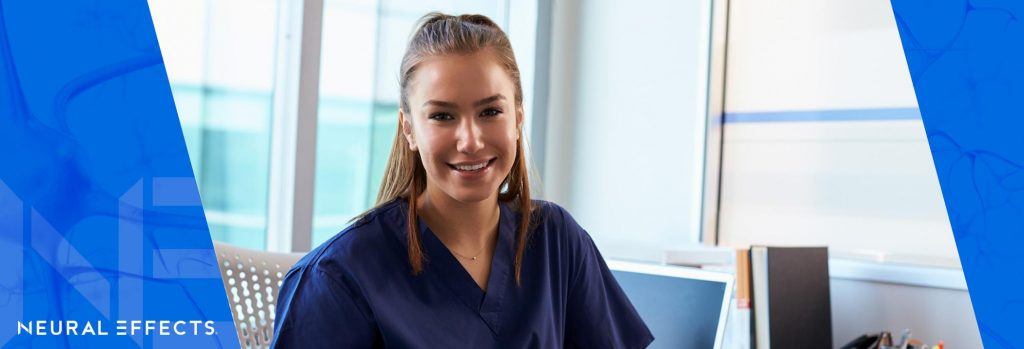After you’re diagnosed with a concussion, you may have a lot of questions, such as:
- How serious is my concussion?
- What should I do next?
- Is there anything I shouldn’t do?
- How long will concussion recovery take?
- When can I get back to my regular activities?
Every concussion is unique, and so are its symptoms. Symptoms of concussion can range from mild to severe, and from sporadic to constant. They might appear immediately after an injury or not until days later. They might last from a few hours to days, weeks, or even months after the concussion. As a result, the answer to those questions can vary from patient to patient.
Something that can help is a thorough acute concussion evaluation. At our concussion management clinic in Provo, Utah, we provide additional guidance and therapy for residents of the Utah Valley area.
Our goal is to provide quick, efficient therapy to help our patients recover from a mild traumatic brain injury (mild TBI) at a faster rate than would naturally happen without treatment. This early, intense therapy also helps to prevent long-term, or even lifetime problems, that sometimes result from a concussion.
Typically, our clients have already been diagnosed with a concussion at an emergency department, general healthcare provider’s office, or sports medicine clinic when they come to us. Ideally, we like to see patients within 24-48 hours of their injury. However, we will see patients up to three months after the date of their injury.
In this article, we’ll discuss the complete concussion assessment process at our clinic so you’ll know exactly what to expect at your appointment.
If you live in Provo, Salt Lake City, or anywhere else in the valley area, we can help you recover from your concussion and reduce your chance of long-term symptoms. We accept most types of medical insurance. Schedule your evaluation today.
Post-Concussion Evaluation: What’s the Process?
Every patient meets with an experienced medical professional for a comprehensive evaluation of concussion symptoms and effects during their initial consultation. We want to make sure we have a complete picture of your situation, including any pre-existing conditions or undiagnosed complications from the injury that might affect your specific concussion care.
In this section, we’ll explain what happens during each part of the evaluation. Your acute concussion evaluation will consist of:
- Completion of a Post-Concussion Symptom Scale
- A Review of Your Medical History
- A Review of Any Imaging (CT Scans, MRIs, and/or X-Rays)
- A Cranial Nerve Exam
- A Cervical Spine Exam
- A Balance Assessment.
If we find anything of concern during the exam that needs to be addressed prior to treatment, our access to on-site imaging and our working relationship with local neurosurgeons means we can get it quickly checked out and get you into therapy as soon as possible.
The Post-Concussion Symptom Scale
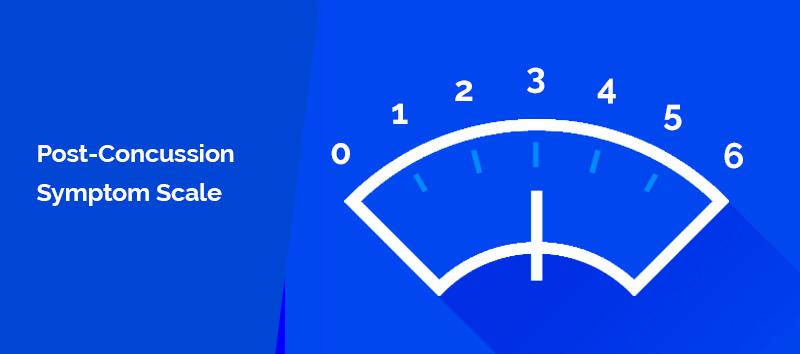
The session begins with a post-concussion symptom scale. We give you a concussion symptom checklist and ask you to rate your symptoms on a scale from zero (no symptoms) to six (the worst possible) in terms of severity. Which symptoms are worst for you helps guide our decisions as to the focus and intensity of certain therapies.
You’ll complete this scale before and after every therapy session. This assessment tool is one way we closely monitor how patients are feeling and the immediate effects of therapy, and we make adjustments based on those results. We want to see where patients are improving and where they are still having problems.
By the end of treatment, we want to see patients scoring a zero (or one) on all symptoms.
Medical History: A Holistic View
An important part of the initial evaluation is getting information about the head injury that caused the concussion as well as getting a holistic view of every patient’s health. We need to be aware of any pre-existing health conditions that might affect your recovery and your tolerance for therapy.
How Did You Get the Concussion?
It’s important for us to know exactly what happened during the injury that caused your head trauma. Did you fall? Did you get hit in the neck or the head? Did your head whip backwards or sideways? Did you experience loss of consciousness? Was any other part of your body injured?
Note: You don’t have to lose consciousness or get hit in the head to have a concussion. Your brain is soft tissue that is suspended in fluid inside your skull. You can get a concussion any time your brain gets jostled enough to slam into your skull.
We’ll talk about what happens to the brain during and after a brain injury and how that causes concussion symptoms.
Medical History
Sometimes the injury that caused the concussion also resulted in an injury to another area that can affect a patient’s ability to do therapy. For example, if you fall and break your arm in addition to getting your concussion, we’ll need to exclude certain exercises from your therapy regimen.
Other pre-existing conditions matter, too. For example, our therapy involves some aerobic exercise, so if you have asthma, we may need to take precautions before having you do any cardio. Vision problems often result from a concussion, so it helps to know if those problems were pre-existing or caused by the concussion.
We can definitely be creative in how we accomplish our therapy goals, but knowing about pre-existing conditions helps to provide the safest and most efficient therapy.
Imaging: What Do the Scans Show?
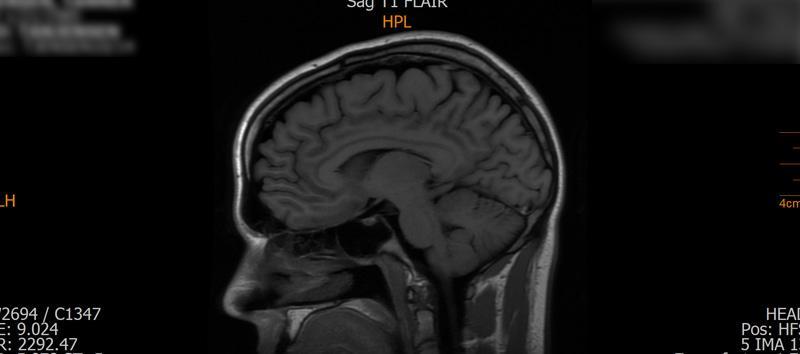
Very often, patients come to us with a CT scan or an MRI that they had done during the initial concussion diagnostic process. While these scans can’t diagnose a concussion, they might have been done to check for a skull fracture or to look for signs of bleeding in the brain.
If you have had any imaging done, bring the scans with you. We can look at and discuss them together.
If you haven’t had any scans done, we’ll assess the need for them during your concussion evaluation. We have an X-ray machine and an MRI machine on-site, so we can quickly and easily get those done if we believe they are necessary.
Additionally, we have a close relationship with a local neurosurgery practice that can quickly assess any serious issues (such as a fracture or a herniated disc) that show up on imaging scans. If anything else turns up (for example, an endocrine issue), we’ll direct you to the appropriate specialist.
Who Needs a Scan?
Not everyone needs to have neuroimaging done, but there are several reasons to order them. In addition to looking for traumatic structural damage to the skull or for signs of bleeding in the brain, we might need to check for fractures in the neck. Also, if we suspect there is a herniated disc in the spine, we’ll order an MRI.
Who Doesn’t Need a Scan?
We try to avoid unnecessary radiation exposure to young and otherwise-healthy individuals. In addition, imaging can be expensive, so we want to reduce your financial burden whenever possible. If, after a thorough medical history and examination, we don’t see any indication of conditions that necessitate imaging, we won’t order any. Rest assured, however, that we closely monitor our patients. We won’t hesitate to order a scan if the need arises during treatment.
Cranial Nerve Exam
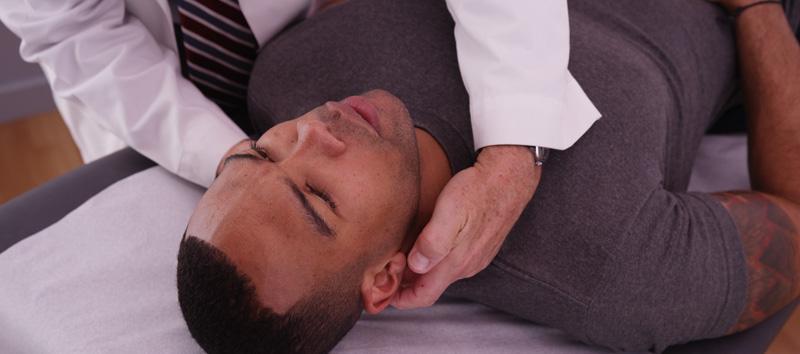
A crucial step in the concussion evaluation is a complete cranial nerve exam. The cranial nerves are twelve sets of paired nerves that control various functions throughout the body (mostly the senses and muscle movement). Needless to say, you want them to be functioning properly.
During this exam, we look for indications of any problems with the nerves related to vision and eye movement, such as irregular eye movements, an abnormal response of the pupils to light, double vision, or problems in the field of vision.
We also look for signs of damage to facial nerves. We’ll test for feeling in areas near the eye and on the face. We’ll check for symmetry when the patient smiles or puffs up their cheeks with air. Lack of sensation or other imbalances could indicate nerve damage.
We also examine the jaw area. Joint problems while clenching teeth could cause pain or headaches associated with concussions.
We might ask you to shrug your shoulders. Weakness on one side, or the inability to move one side, indicates dysfunction.
Examining these nerves helps us determine how severe an injury is. It also helps us determine if there’s any indication of nerve damage that requires a follow-up referral to a neurosurgeon.
Cervical Spine Exam
A cervical spine exam is another important step in the acute concussion evaluation.
A lot of this exam consists of hands-on palpation of the spine, neck, arms, and hands. We’re going to feel for anything abnormal that could indicate a fracture or a herniated disc. We’ll not only measure strength, but also whether strength is equal on both sides of the body.
If we find any signs of a neck or spine injury that would require any additional imaging or a referral to a specialist, we will immediately arrange for that.
Balance Assessment

Since a concussion often causes balance problems, we always do a balance assessment during the evaluation.
One of the best ways to do this is to administer a Balance Error Scoring System (BESS) test. This test consists of a series of simple balance exercises done with closed eyes. It is often used with athletes as a sideline concussion evaluation tool to determine if a concussion has possibly taken place, and as an assessment to determine if the athlete is ready to return to play.
The results of this test help us determine which areas to target during therapy.
What’s Next?
After the intensive concussion evaluation, we’ll determine the next steps to take to treat your acute concussion.
We want to be sure it’s safe for our patients to begin therapy, so if your evaluation turns up an issue that we feel needs to be checked out by a specialist, we’ll wait for those results before proceeding.
Sub-symptom level physical activity and active therapy after a mild traumatic brain injury is the key to rapid recovery, so if the results of your exam indicate that you’re a good candidate for immediate treatment, we will create a treatment plan and get started right away — sometimes the same day as your evaluation.
Concussion Therapy at Neural Effects: What Makes Us Different?
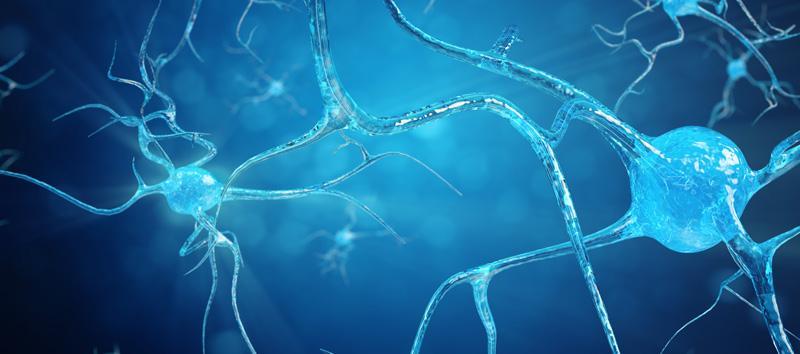
Therapy at Neural Effects is intense and active — sometimes not what patients expect.
Your therapy team will consist of a doctor of nursing practice (DNP) with years of neurosurgery experience, neuromuscular physical therapists, and (if needed) a neuropsychologist.
We walk patients through a unique combination of exercises that are designed to restore healthy brain function post-concussion. You’ll perform a mix of neuromuscular, balance, vision, and cognitive therapies that are appropriate to your symptoms and your specific concussion evaluation results.
You can expect to come to therapy two to three times per week. (As a reference, it might take up to four weeks to get that amount of therapy in a traditional clinic.) You’ll also be given therapy homework to do on days that you don’t come to the clinic; this work at home will help you recover more quickly.
Therapy typically lasts one to two weeks, but therapists will continually evaluate your symptoms and adjust your therapy as needed.
We believe that providing you with this immediate, efficient concussion care will greatly increase your chances of making a full recovery from your concussion, in the most efficient manner available. We want to help you get back to your life as soon as possible.
If you live in Provo, Salt Lake City, or anywhere else in the valley area, we can help you recover from your concussion and reduce your chance of long-term symptoms. We accept most types of medical insurance. Schedule your evaluation today.
